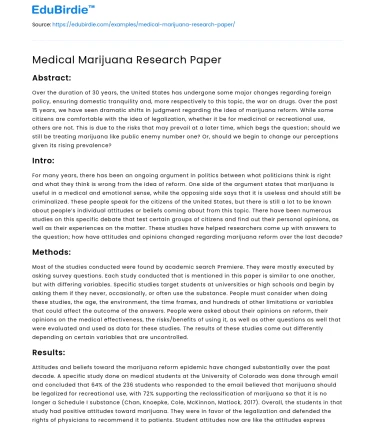Abstract:
Over the duration of 30 years, the United States has undergone some major changes regarding foreign policy, ensuring domestic tranquility and, more respectively to this topic, the war on drugs. Over the past 15 years, we have seen dramatic shifts in judgment regarding the idea of marijuana reform. While some citizens are comfortable with the idea of legalization, whether it be for medicinal or recreational use, others are not. This is due to the risks that may prevail at a later time, which begs the question; should we still be treating marijuana like public enemy number one? Or, should we begin to change our perceptions given its rising prevalence?
Intro:
For many years, there has been an ongoing argument in politics between what politicians think is right and what they think is wrong from the idea of reform. One side of the argument states that marijuana is useful in a medical and emotional sense, while the opposing side says that it is useless and should still be criminalized. These people speak for the citizens of the United States, but there is still a lot to be known about people’s individual attitudes or beliefs coming about from this topic. There have been numerous studies on this specific debate that test certain groups of citizens and find out their personal opinions, as well as their experiences on the matter. These studies have helped researchers come up with answers to the question; how have attitudes and opinions changed regarding marijuana reform over the last decade?
Save your time!
We can take care of your essay
- Proper editing and formatting
- Free revision, title page, and bibliography
- Flexible prices and money-back guarantee
Methods:
Most of the studies conducted were found by academic search Premiere. They were mostly executed by asking survey questions. Each study conducted that is mentioned in this paper is similar to one another, but with differing variables. Specific studies target students at universities or high schools and begin by asking them if they never, occasionally, or often use the substance. People must consider when doing these studies, the age, the environment, the time frames, and hundreds of other limitations or variables that could affect the outcome of the answers. People were asked about their opinions on reform, their opinions on the medical effectiveness, the risks/benefits of using it, as well as other questions as well that were evaluated and used as data for these studies. The results of these studies come out differently depending on certain variables that are uncontrolled.
Results:
Attitudes and beliefs toward the marijuana reform epidemic have changed substantially over the past decade. A specific study done on medical students at the University of Colorado was done through email and concluded that 64% of the 236 students who responded to the email believed that marijuana should be legalized for recreational use, with 72% supporting the reclassification of marijuana so that it is no longer a Schedule I substance (Chan, Knoepke, Cole, McKinnon, Matlock, 2017). Overall, the students in that study had positive attitudes toward marijuana. They were in favor of the legalization and defended the rights of physicians to recommend it to patients. Student attitudes now are like the attitudes expressed in a 1991 survey by the American Society of Clinical Oncologists (ASCO), which showed that 48% of respondents would prescribe marijuana if it were legally available (Chan, 2017). Another study was conducted by The Institute for Social Research at the University of Michigan. Data that has been collected from Monitoring the Future surveys in this study were from between the years 1991 to 2016. The relevance of this data is competent because it also falls between the years 2009 and 2016. Two hypotheses were tested: one was that as the prevalence of cigarettes and alcohol began to fall, marijuana use was expected to rise since 2005. The second hypothesis claimed that marijuana use would not rise “since 2005 because the association of perceived risk of harm and marijuana use has weakened” (Miech, Johnston, O’Malley, 2017).
Discussion:
Cumulatively the studies that I have reviewed found that over the last decade, marijuana prevalence has risen slightly and increased overall. Also, attitudes towards perceived risks, potential medicinal values, and reclassification have also shown a difference within the last decade; generally, with states that have reformed their marijuana laws, people residing within tend to lean towards more positive attitudes and beliefs than states without any marijuana reform. I found that marijuana prevalence has increased substantially, but the number of adolescents using the substance was less than I expected despite the growing prevalence. The reasoning for this is due to the decline of alcohol and tobacco use since 2005, and if there had not been any decline, it was noted that marijuana use would be more prevalent in our youth.






 Stuck on your essay?
Stuck on your essay?

